Intelligent Design of Building Materials: Development of an AI-Based Method for Cement-Slag Concrete Design
Abstract
:1. Introduction
2. Research Methods
2.1. Description of the Dataset
2.2. Algorithm
2.2.1. The Beetle Antennae Search Algorithm (BAS)
2.2.2. Random Forests (RF)
2.2.3. Decision Tree (DT)
2.2.4. Support Vector Machine (SVM)
2.3. Construction of the Cost Objective Function
- (1)
- Scope constraints
- (2)
- Proportional constraints
- (3)
- Volume constraint
- (4)
- UCS constraint
2.4. The Multi-Objective BAS Algorithm
2.4.1. Multi-Objective Problem
2.4.2. Pareto Optimality
2.4.3. The Multi-Objective BAS Algorithm
2.4.4. Decision-Making Method
3. Results and Analysis
3.1. Hyperparameter Tuning
3.2. Evaluation of UCS Prediction Model
3.3. Evaluation of Multi-Objective Optimization Models
4. Conclusions
- (1)
- BAS is used to tune the hyperparameters of RF, DT, and SVM. The RSME values of RF and SVM converge gradually with the increase in the number of iterations, while the RMSE value of DT does not change with the increase in the number of iterations, demonstrating that BAS has a poor effect on DT hyperparameter tuning, but a better effect on SVM and RF hyperparameter tuning.
- (2)
- By comparing the predicted value and actual value of RF, DT, and SVM optimized by BAS, it is found that RF and SVM have a better prediction effect on concrete UCS. However, due to the over-fitting of SVM, the RF model was selected in this study to predict the UCS of concrete considering the R values of the training set and test set of the RF model are 0.9832 and 0.9516, respectively.
- (3)
- To find the best mixture ratio for the optimization of the UCS and cost of concrete, this paper uses TOPSIS to rank the scores of twenty Pareto front optimal solutions. The MOBAS model proposed based on the weighted method can smoothly find the Pareto optimal solution for the UCS of concrete. The multi-objective optimization model proposed in this paper can effectively reduce the cost of concrete without changing the UCS of concrete and the multi-objective optimization model has a good effect and strong generalization ability. The Pareto front optimal solution with the highest score is 1 and the UCS of the corresponding concrete is 119.48 MPa and the cost is 37.29 USD/m3.
Author Contributions
Funding
Institutional Review Board Statement
Data Availability Statement
Conflicts of Interest
References
- Nogueira, C.L. Anti-plane shear strength of plain concrete. Mater. Today Commun. 2020, 24, 101051. [Google Scholar] [CrossRef]
- Strieder, E.; Hilber, R.; Stierschneider, E.; Bergmeister, K. Fe-study on the effect of gradient concrete on early constraint and crack risk. Appl. Sci. 2018, 8, 246. [Google Scholar] [CrossRef] [Green Version]
- Ambroziak, A.; Ziolkowski, P. Concrete compressive strength under changing environmental conditions during placement processes. Materials 2020, 13, 4577. [Google Scholar] [CrossRef]
- Zounemat-Kermani, M.; Alizamir, M.; Yaseen, Z.M.; Hinkelmann, R. Concrete corrosion in wastewater systems: Prediction and sensitivity analysis using advanced extreme learning machine. Front. Struct. Civ. Eng. 2021, 15, 444–460. [Google Scholar] [CrossRef]
- Tian, Y.; Jin, N.; Jin, X. Coupling effect of temperature and relative humidity diffusion in concrete under ambient conditions. Constr. Build. Mater. 2018, 159, 673–689. [Google Scholar] [CrossRef]
- Bressi, S.; Fiorentini, N.; Huang, J.; Losa, M. Crumb rubber modifier in road asphalt pavements: State of the art and statistics. Coatings 2019, 9, 384. [Google Scholar] [CrossRef] [Green Version]
- Huang, J.; Leandri, P.; Cuciniello, G.; Losa, M. Mix design and laboratory characterisation of rubberised mixture used as damping layer in pavements. Int. J. Pavement Eng. 2021, 1–15. [Google Scholar] [CrossRef]
- Imran, H.; Al-Abdaly, N.M.; Shamsa, M.H.; Shatnawi, A.; Ibrahim, M.; Ostrowski, K.A. Development of prediction model to predict the compressive strength of eco-friendly concrete using multivariate polynomial regression combined with stepwise method. Materials 2022, 15, 317. [Google Scholar] [CrossRef] [PubMed]
- Huang, J.; Duan, T.; Zhang, Y.; Liu, J.; Zhang, J.; Lei, Y. Predicting the permeability of pervious concrete based on the beetle antennae search algorithm and random forest model. Adv. Civ. Eng. 2020, 2020, 8863181. [Google Scholar] [CrossRef]
- Huang, J.; Zhou, M.; Yuan, H.; Sabri, M.M.S.; Li, X. Prediction of the compressive strength for cement-based materials with metakaolin based on the hybrid machine learning method. Materials 2022, 15, 3500. [Google Scholar] [CrossRef]
- Ahmad, M.; Tang, X.-W.; Ahmad, F.; Pirhadi, N.; Wan, X.; Cheng, K. Probabilistic evaluation of cpt-based seismic soil liquefaction potential: Towards the integration of interpretive structural modeling and bayesian belief network. Res. Square 2021. submitted. [Google Scholar] [CrossRef] [PubMed]
- Huang, J.; Li, X.; Kumar, G.S.; Deng, Y.; Gong, M.; Dong, N. Rheological properties of bituminous binder modified with recycled waste toner. J. Clean. Prod. 2021, 317, 128415. [Google Scholar] [CrossRef]
- Wang, Q.-A.; Zhang, C.; Ma, Z.-G.; Huang, J.; Ni, Y.-Q.; Zhang, C. Shm deformation monitoring for high-speed rail track slabs and bayesian change point detection for the measurements. Constr. Build. Mater. 2021, 300, 124337. [Google Scholar] [CrossRef]
- Wang, Q.-A.; Zhang, J.; Huang, J. Simulation of the compressive strength of cemented tailing backfill through the use of firefly algorithm and random forest model. Shock. Vib. 2021, 2021, 5536998. [Google Scholar] [CrossRef]
- Xu, W.; Huang, X.; Huang, J.; Yang, Z. Structural analysis of backfill highway subgrade on the lower bearing capacity foundation using the finite element method. Adv. Civ. Eng. 2021, 2021, 1690168. [Google Scholar] [CrossRef]
- Liang, X.; Yu, X.; Chen, C.; Ding, G.; Huang, J. Towards the low-energy usage of high viscosity asphalt in porous asphalt pavements: A case study of warm-mix asphalt additives. Case Stud. Constr. Mater. 2022, 16, e00914. [Google Scholar] [CrossRef]
- Liu, G.; Wang, M.; Yu, Q.; Li, Q.; Wang, L. Effect of alkaline electrolyzed water on performance improvement of green concrete with high volume of mineral admixtures. J. Renew. Mater. 2021, 9, 2051–2065. [Google Scholar] [CrossRef]
- Wang, A.G.; Deng, M.; Sun, D.S.; Li, B.; Tang, M.S. Effect of crushed air-cooled blast furnace slag on mechanical properties of concrete. J. Wuhan Univ. Technol.-Mater. Sci. Ed. 2012, 27, 758–762. [Google Scholar] [CrossRef]
- Liu, B.; Luo, G.; Xie, Y. Effect of curing conditions on the permeability of concrete with high volume mineral admixtures. Constr. Build. Mater. 2018, 167, 359–371. [Google Scholar] [CrossRef]
- Ren, J.; Yin, C. Investigating mechanical characteristics of aggregate structure for road materials. Int. J. Pavement Eng. 2022, 23, 372–386. [Google Scholar] [CrossRef] [Green Version]
- Ren, J.; Zhang, L.; Zhao, H.; Zhao, Z.; Wang, S. Determination of the fatigue equation for the cement-stabilized cold recycled mixtures with road construction waste materials based on data-driven. Int. J. Fatigue 2022, 158, 106765. [Google Scholar] [CrossRef]
- Ren, J.; Zhao, H.; Zhang, L.; Zhao, Z.; Xu, Y.; Cheng, Y.; Wang, M.; Chen, J.; Wang, J. Design optimization of cement grouting material based on adaptive boosting algorithm and simplicial homology global optimization. J. Build. Eng. 2022, 49, 104049. [Google Scholar] [CrossRef]
- Vibha, V.; Reddy, B.V.V. A study on properties of concrete made with processed granulated blast furnace slag as fine aggregate. In Proceedings of the 5th International Conference on Building Materials and Construction (ICBMC), Tokyo, Japan, 26–29 February 2020. [Google Scholar]
- Ojha, P.N.; Singh, A.; Singh, B. Experimental investigations on substitution of natural sand in concrete with copper slag and blast furnace slag. J. Asian Concr. Fed. 2021, 7, 1–11. [Google Scholar] [CrossRef]
- Singh, A.; Bhadauria, S.S.; Kushwah, S.S.; Tare, K. The study on optimization of cement and fine aggregate by blast furnace slag in concrete. AIP Conf. Proc. 2019, 2158, 020031. [Google Scholar] [CrossRef]
- Yang, C.; Wang, S.; Xu, F.; Li, W.; Du, D. Relating rapid chloride migration coefficient of blast furnace slag concrete to capillary pore structure parameters. In Proceedings of the 2nd International Conference on Building Materials and Materials Engineering (ICBMM), Lisbon, Portugal, 26–28 September 2018. [Google Scholar]
- Cui, X.N.; Wang, Q.C.; Zhang, R.L.; Dai, J.P.; Li, S. Machine learning prediction of concrete compressive strength with data enhancement. J. Intell. Fuzzy Syst. 2021, 41, 7219–7228. [Google Scholar] [CrossRef]
- Benton, W.C. Machine learning systems and intelligent applications. IEEE Softw. 2020, 37, 43–49. [Google Scholar] [CrossRef]
- Silva, P.F.S.; Moita, G.F.; Arruda, V.F. Machine learning techniques to predict the compressive strength of concrete. Rev. Int. Métodos Numéricos Cálculo Diseño Ing. 2020, 36. [Google Scholar] [CrossRef]
- Shamsabadi, E.A.; Roshan, N.; Hadigheh, S.A.; Nehdi, M.L.; Khodabakhshian, A.; Ghalehnovi, M. Machine learning-based compressive strength modelling of concrete incorporating waste marble powder. Constr. Build. Mater. 2022, 324, 126592. [Google Scholar] [CrossRef]
- Li, K.; Long, Y.; Wang, H.; Wang, Y.-F. Modeling and sensitivity analysis of concrete creep with machine learning methods. J. Mater. Civ. Eng. 2021, 33, 04021206. [Google Scholar] [CrossRef]
- Khan, M.A.; Aslam, F.; Javed, M.F.; Alabduljabbar, H.; Deifalla, A.F. New prediction models for the compressive strength and dry-thermal conductivity of bio-composites using novel machine learning algorithms. J. Clean. Prod. 2022, 350, 131364. [Google Scholar] [CrossRef]
- Aslam, F.; Elkotb, M.A.; Iqtidar, A.; Khan, M.A.; Javed, M.F.; Usanova, K.I.; Khan, M.I.; Alamri, S.; Musarat, M.A. Compressive strength prediction of rice husk ash using multiphysics genetic expression programming. Ain Shams Eng. J. 2022, 13, 101593. [Google Scholar] [CrossRef]
- Wang, X.-Y.; Park, K.-B. Analysis of the compressive strength development of concrete considering the interactions between hydration and drying. Cem. Concr. Res. 2017, 102, 1–15. [Google Scholar] [CrossRef]
- Chen, H.C.; Qian, C.X.; Liang, C.Y.; Kang, W.C. An approach for predicting the compressive strength of cement-based materials exposed to sulfate attack. PLoS ONE 2018, 13, e0191370. [Google Scholar] [CrossRef] [Green Version]
- Oezcan, F.; Atis, C.D.; Karahan, O.; Uncuoglu, E.; Tanyildizi, H. Comparison of artificial neural network and fuzzy logic models for prediction of long-term compressive strength of silica fume concrete. Adv. Eng. Softw. 2009, 40, 856–863. [Google Scholar] [CrossRef]
- Astutiningsih, S.; Sura, W.; Zakiyuddin, A.; Kusrini, E.; Juwono, F.H.; Yatim, A.; Setiawan, E.A. Comparison of the compressive strength and the microstructure of metakaolin metastar and metakaolin bangka as additive in ordinary portland cement. E3s Web Conf. 2018, 67, 03023. [Google Scholar] [CrossRef]
- Huang, J.; Zhang, J.; Ren, J.; Chen, H. Anti-rutting performance of the damping asphalt mixtures (dams) made with a high content of asphalt rubber (ar). Constr. Build. Mater. 2021, 271, 121878. [Google Scholar] [CrossRef]
- Gao, Y.; Huang, J.; Li, M.; Dai, Z.; Jiang, R.; Zhang, J. Chemical modification of combusted coal gangue for u(vi) adsorption: Towards a waste control by waste strategy. Sustainability 2021, 13, 8421. [Google Scholar] [CrossRef]
- Xu, W.; Huang, X.; Yang, Z.; Zhou, M.; Huang, J. Developing hybrid machine learning models to determine the dynamic modulus (e*) of asphalt mixtures using parameters in witczak 1-40d model: A comparative study. Materials 2022, 15, 1791. [Google Scholar] [CrossRef]
- Zhang, S.; Fan, Y.; Huang, J.; Shah, S.P. Effect of nano-metakaolinite clay on hydration behavior of cement-based materials at early curing age. Constr. Build. Mater. 2021, 291, 123107. [Google Scholar] [CrossRef]
- Ma, H.; Liu, J.; Zhang, J.; Huang, J. Estimating the compressive strength of cement-based materials with mining waste using support vector machine, decision tree, and random forest models. Adv. Civ. Eng. 2021, 2021, 6629466. [Google Scholar] [CrossRef]
- Ren, J.; Li, D.; Xu, Y.; Huang, J.; Liu, W. Fatigue behaviour of rock asphalt concrete considering moisture, high-temperature, and stress level. Int. J. Pavement Eng. 2021, 1–11. [Google Scholar] [CrossRef]
- Ren, J.; Xu, Y.; Zhao, Z.; Chen, J.; Cheng, Y.; Huang, J.; Yang, C.; Wang, J. Fatigue prediction of semi-flexible composite mixture based on damage evolution. Constr. Build. Mater. 2022, 318, 126004. [Google Scholar] [CrossRef]
- Huang, J.; Duan, T.; Lei, Y.; Hasanipanah, M. Finite element modeling for the antivibration pavement used to improve the slope stability of the open-pit mine. Shock. Vib. 2020, 2020, 6650780. [Google Scholar] [CrossRef]
- Ren, J.; Xu, Y.; Huang, J.; Wang, Y.; Jia, Z. Gradation optimization and strength mechanism of aggregate structure considering macroscopic and mesoscopic aggregate mechanical behaviour in porous asphalt mixture. Constr. Build. Mater. 2021, 300, 124262. [Google Scholar] [CrossRef]
- Huang, J.; Alyousef, R.; Suhatril, M.; Baharom, S.; Alabduljabbar, H.; Alaskar, A.; Assilzadeh, H. Influence of porosity and cement grade on concrete mechanical properties. Adv. Concr. Constr. 2020, 10, 393–402. [Google Scholar]
- Huang, J.; Zhang, J.; Gao, Y. Intelligently predict the rock joint shear strength using the support vector regression and firefly algorithm. Lithosphere 2021, 2021, 2467126. [Google Scholar] [CrossRef]
- Huang, J.; Asteris, P.G.; Pasha, S.M.K.; Mohammed, A.S.; Hasanipanah, M. A new auto-tuning model for predicting the rock fragmentation: A cat swarm optimization algorithm. Eng. Comput. 2020, 1–12. [Google Scholar] [CrossRef]
- Huang, J.; Zhou, M.; Sabri, M.M.S.; Yuan, H. A novel neural computing model applied to estimate the dynamic modulus (dm) of asphalt mixtures by the improved beetle antennae search. Sustainability 2022, 14, 5938. [Google Scholar] [CrossRef]
- Kumar, A.; Arora, H.C.; Kapoor, N.R.; Mohammed, M.A.; Kumar, K.; Majumdar, A.; Thinnukool, O. Compressive strength prediction of lightweight concrete: Machine learning models. Sustainability 2022, 14, 2404. [Google Scholar] [CrossRef]
- Song, Y.; Zhao, J.; Ostrowski, K.A.; Javed, M.F.; Ahmad, A.; Khan, M.I.; Aslam, F.; Kinasz, R. Prediction of compressive strength of fly-ash-based concrete using ensemble and non-ensemble supervised machine-learning approaches. Appl. Sci. 2022, 12, 361. [Google Scholar] [CrossRef]
- Bardhan, A.; Biswas, R.; Kardani, N.; Iqbal, M.; Samui, P.; Singh, M.; Asteris, P.G. A novel integrated approach of augmented grey wolf optimizer and ann for estimating axial load carrying-capacity of concrete-filled steel tube columns. Constr. Build. Mater. 2022, 337, 127454. [Google Scholar] [CrossRef]
- Yeh, I.C. Modeling of strength of high-performance concrete using artificial neural networks. Cem. Concr. Res. 1998, 28, 1797–1808. [Google Scholar] [CrossRef]
- Standards Association of Australia. Methods of Testing Portland and Blended Cements. In AS 2350; Standards Australia: Sydney, Australia, 2006. [Google Scholar]
- Supplementary Cementitious Materials for Use with Portland and Blended Cement–Slag–Ground Granulated Iron Blast-Furnace Slag. In As 3582.2; Standards Australia International Ltd.: Sydney, Australia, 2016; ISBN 0733740545.
- Zhang, J.; Huang, Y.; Ma, G.; Nener, B. Multi-objective beetle antennae search algorithm. arXiv 2020, arXiv:2002.10090. [Google Scholar]
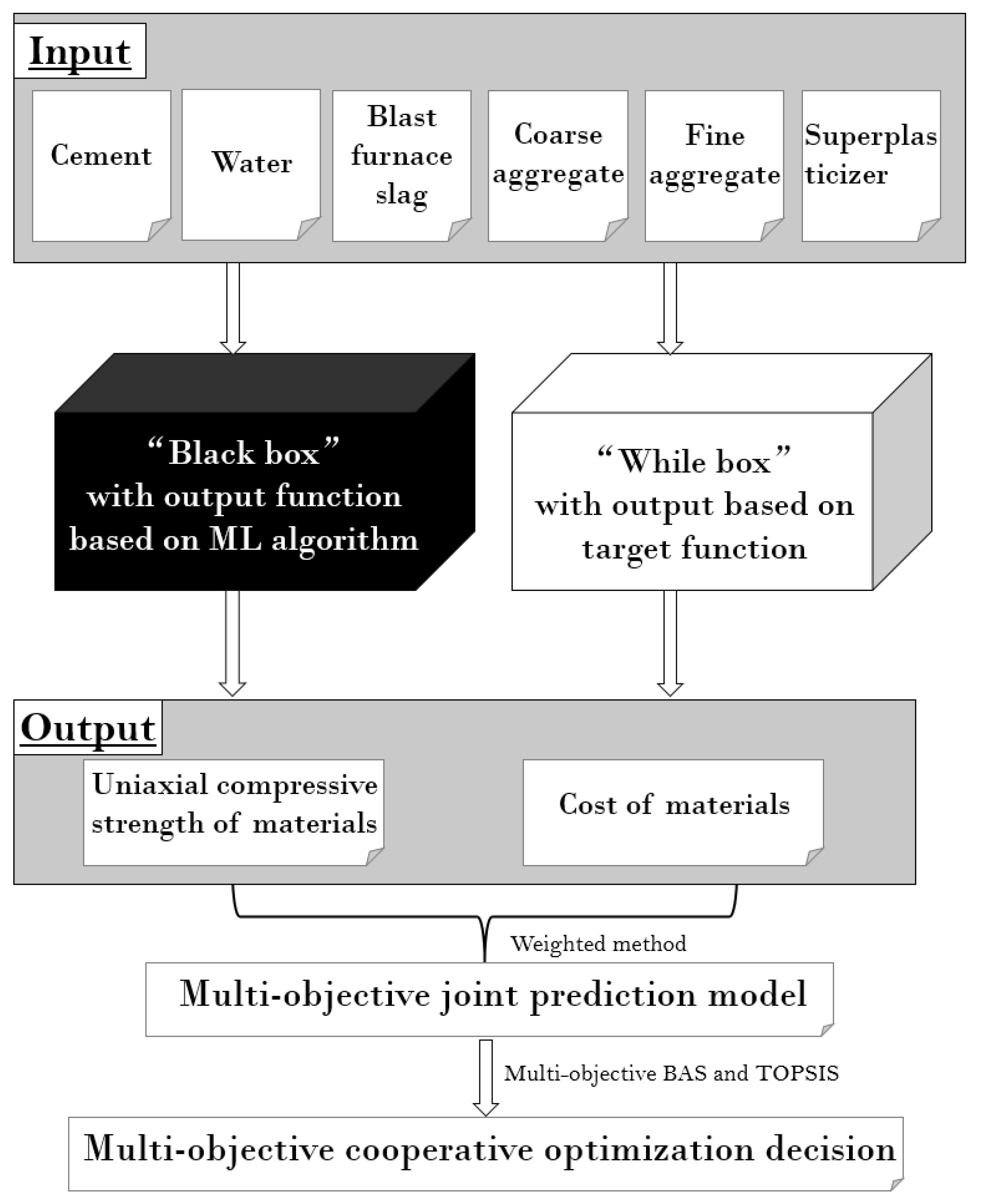
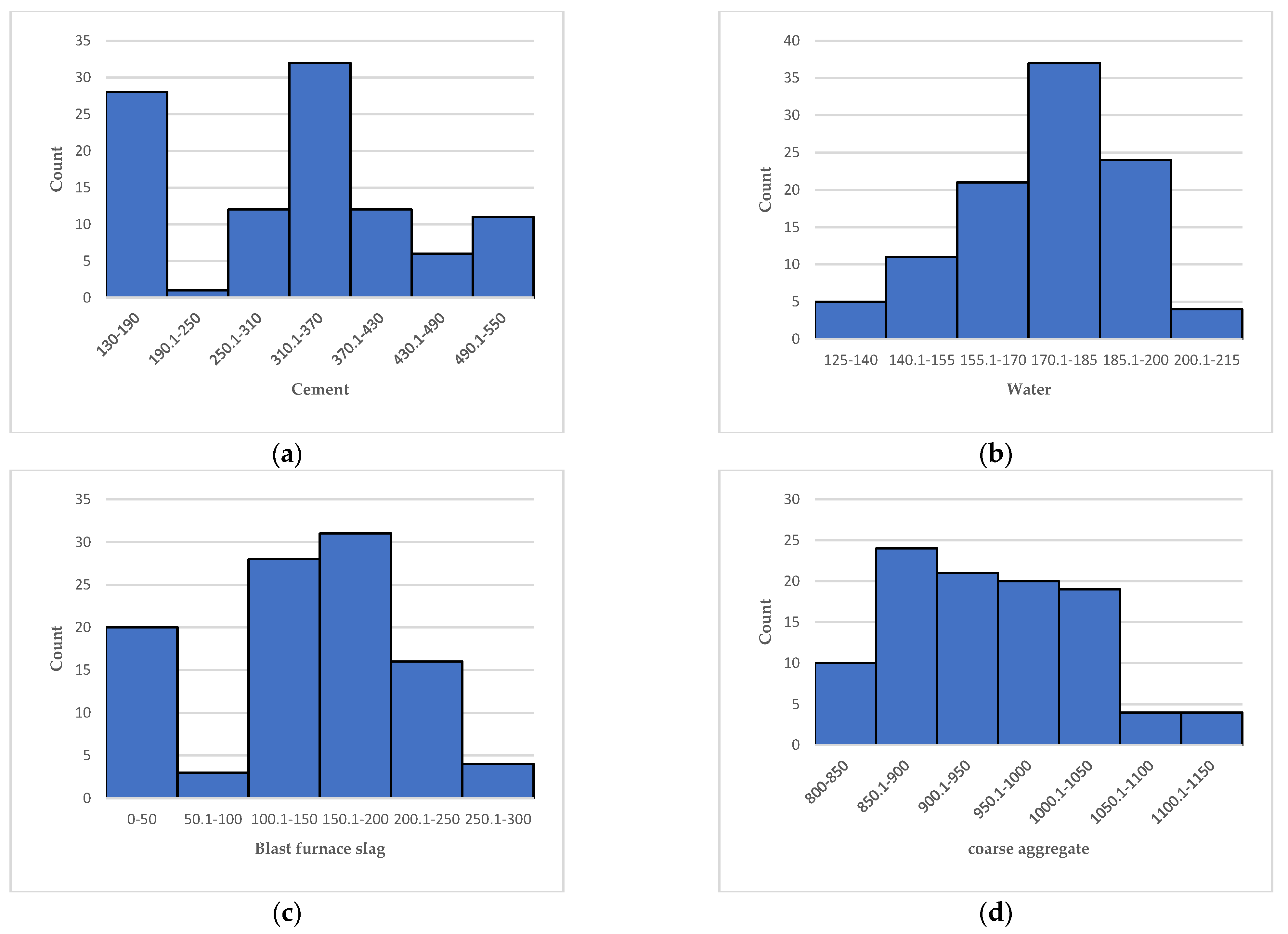

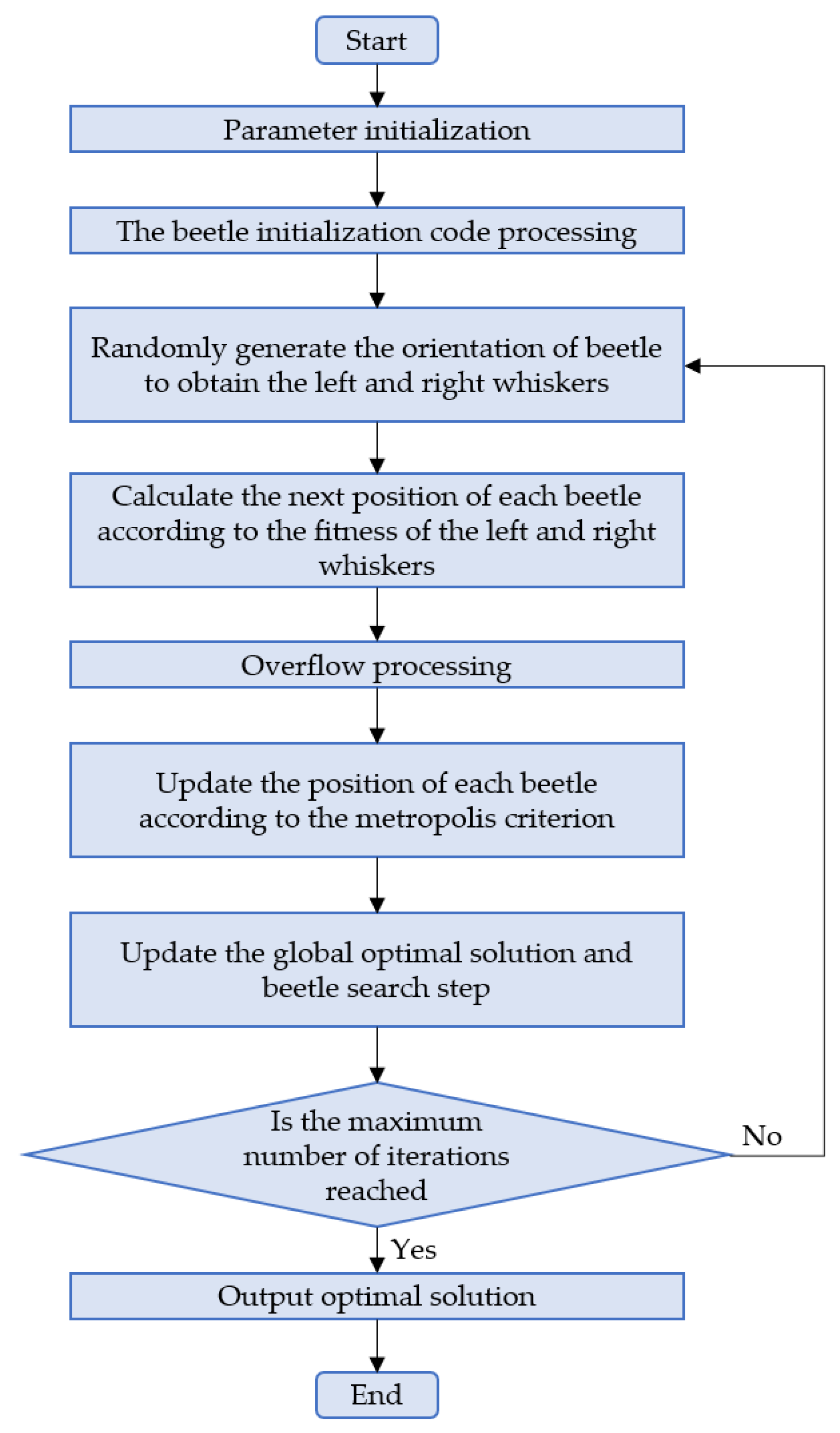
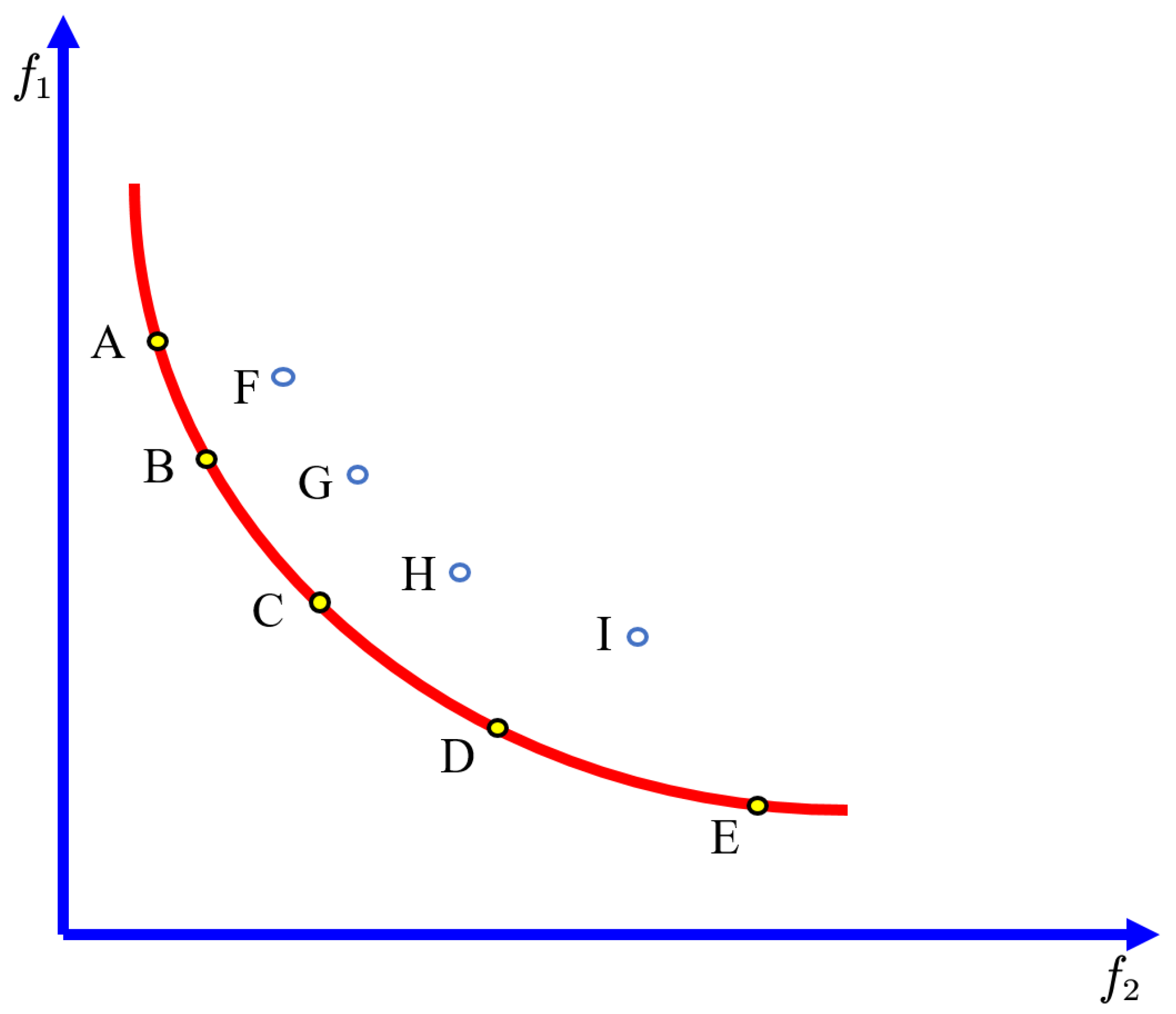

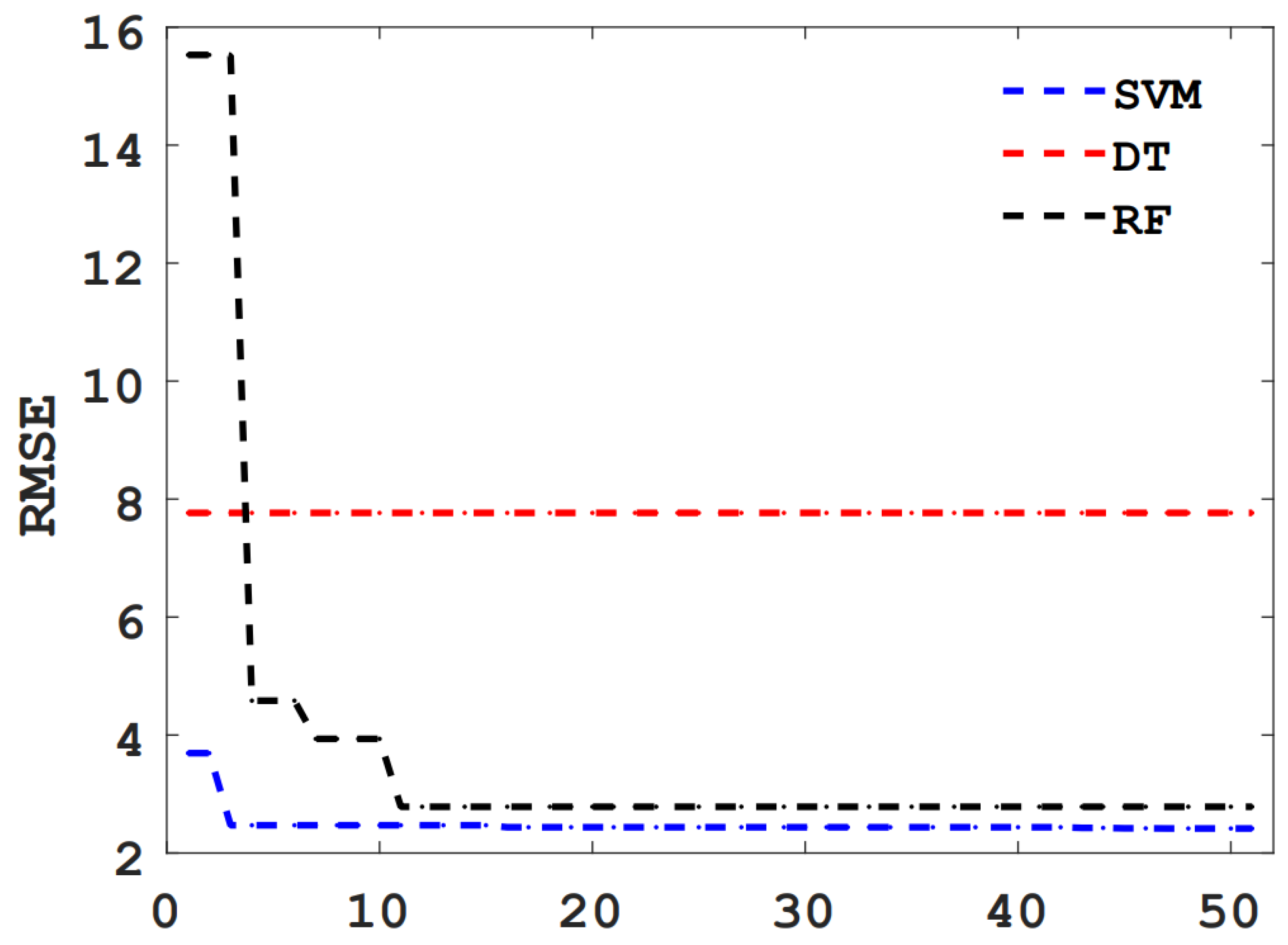
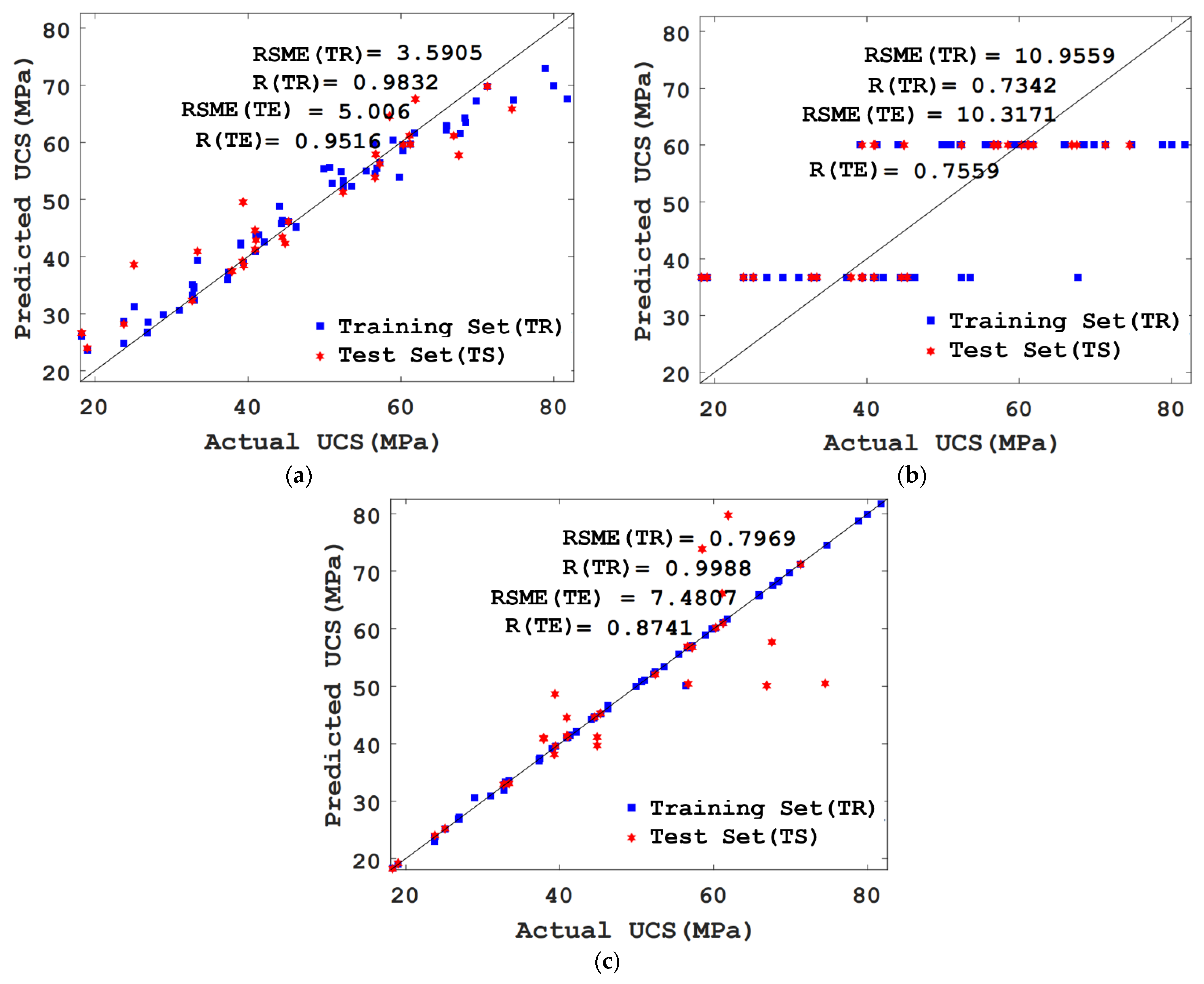

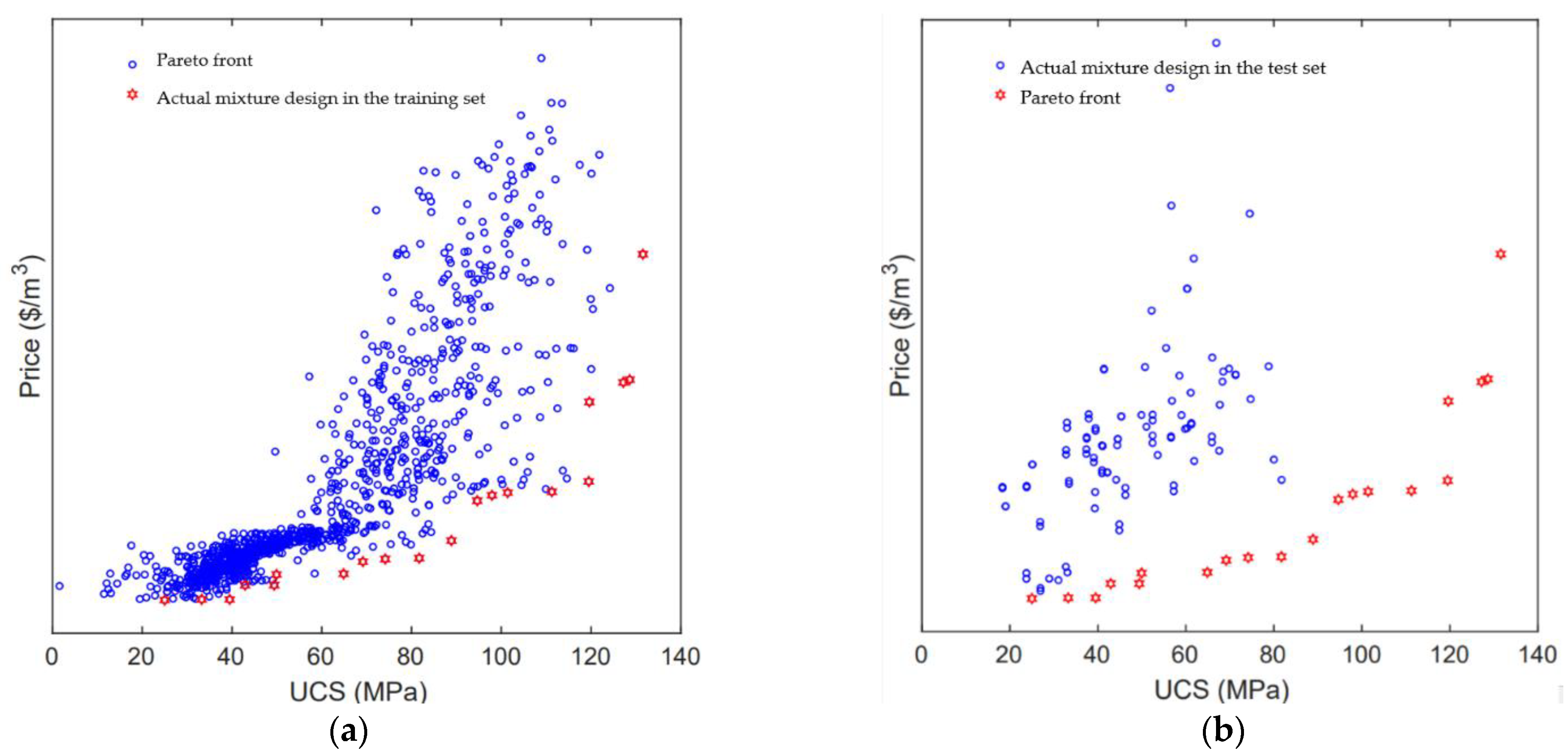
| Variables | Min. | Max. | Median | Mode | Average | Std. | Variance |
|---|---|---|---|---|---|---|---|
| Cement (kg/m3) | 133 | 540 | 313.30 | 313 | 311.65 | 199.20 | 14,207.73 |
| Water (kg/m3) | 126.60 | 214 | 176.50 | 178 | 174.43 | 18.05 | 325.63 |
| Blast furnace slag (kg/m3) | 0 | 282.80 | 150.10 | 0 | 117 | 38.50 | 1479.09 |
| Coarse aggregate (kg/m3) | 810 | 1134.30 | 944.70 | 852.10 | 946.50 | 81.24 | 6599.97 |
| Fine aggregate (kg/m3) | 605 | 992.60 | 788.95 | 755.80 | 744.03 | 75.64 | 5721.46 |
| Superplasticizer (kg/m3) | 2 | 32.20 | 8.23 | 8 | 9.13 | 4.99 | 24.87 |
| Uniaxial compressive strength (MPa) | 18.29 | 81.75 | 45.08 | 71.30 | 47.67 | 15.78 | 249.00 |
| The Name of the Material | Cost (USD/m3) | Density (kg/m3) |
|---|---|---|
| C | 0.0475 | 3150 |
| W | 0.00024 | 1000 |
| SF | 0.0238 | 2750 |
| CA | 0.0048 | 2700 |
| FA | 0.006 | 2600 |
| SP | 1.667 | 1150 |
| Molecular | Denominator | Minimum | Maximum |
| W | C+SF | 0.154 | 1.609 |
| SF | C+SF | 0 | 2.126 |
| SP | C+SF | 0.002 | 0.242 |
| CA | CA+FA | 0.381 | 0.802 |
| CA | C+SF | 0.984 | 8.529 |
| No. | C (kg/m3) | W (kg/m3) | SF (kg/m3) | CA (kg/m3) | FA (kg/m3) | SP (kg/m3) | UCS (MPa) | Cost (USD/m3) | TOPSIS Score |
|---|---|---|---|---|---|---|---|---|---|
| 1 | 484.21 | 191.44 | 239.70 | 1080.26 | 983.94 | 3.72 | 119.48 | 37.29 | 1.00 |
| 2 | 425.05 | 160.85 | 218.01 | 118.05 | 990.24 | 3.80 | 111.26 | 36.12 | 0.96 |
| 3 | 486.61 | 191.96 | 265.97 | 1109.02 | 977.62 | 12.68 | 128.61 | 48.90 | 0.89 |
| 4 | 479.67 | 207.51 | 249.74 | 1127.77 | 973.91 | 13.18 | 127.20 | 48.59 | 0.89 |
| 5 | 537.41 | 213.57 | 156.19 | 1095.44 | 990.81 | 10.48 | 119.62 | 46.36 | 0.89 |
| 6 | 382.38 | 184.80 | 279.26 | 951.99 | 893.64 | 3.58 | 101.42 | 36.02 | 0.88 |
| 7 | 426.78 | 165.80 | 111.73 | 1070.09 | 981.97 | 3.79 | 97.92 | 35.72 | 0.86 |
| 8 | 397.63 | 163.36 | 117.62 | 1132.20 | 939.25 | 4.05 | 94.65 | 35.20 | 0.84 |
| 9 | 306.81 | 200.93 | 212.77 | 1016.68 | 946.51 | 2.70 | 88.89 | 30.55 | 0.82 |
| 10 | 512.76 | 195.40 | 229.63 | 1120.27 | 953.36 | 23.32 | 131.55 | 63.19 | 0.77 |
| 11 | 233.33 | 199.56 | 222.49 | 1126.76 | 963.29 | 3.39 | 81.70 | 28.56 | 0.77 |
| 12 | 207.86 | 168.20 | 262.14 | 937.89 | 986.73 | 2.52 | 74.14 | 28.46 | 0.71 |
| 13 | 289.54 | 196.03 | 123.76 | 1102.29 | 928.70 | 2.20 | 69.16 | 28.16 | 0.67 |
| 14 | 220.52 | 202.97 | 186.89 | 1051.07 | 943.54 | 2.45 | 64.87 | 26.77 | 0.65 |
| 15 | 163.40 | 212.24 | 230.53 | 801.00 | 921.20 | 2.00 | 49.40 | 25.48 | 0.56 |
| 16 | 153.90 | 189.56 | 226.59 | 856.40 | 893.55 | 2.00 | 42.91 | 25.48 | 0.53 |
| 17 | 153.90 | 189.56 | 226.59 | 856.40 | 893.55 | 2.00 | 42.91 | 25.48 | 0.53 |
| 18 | 133.00 | 205.11 | 210.57 | 856.36 | 961.70 | 2.00 | 39.49 | 23.85 | 0.53 |
| 19 | 133.00 | 182.09 | 192.11 | 951.65 | 936.22 | 2.00 | 33.25 | 23.85 | 0.50 |
| 20 | 133.00 | 187.70 | 202.01 | 1097.01 | 775.29 | 2.00 | 25.00 | 23.78 | 0.48 |
Publisher’s Note: MDPI stays neutral with regard to jurisdictional claims in published maps and institutional affiliations. |
© 2022 by the authors. Licensee MDPI, Basel, Switzerland. This article is an open access article distributed under the terms and conditions of the Creative Commons Attribution (CC BY) license (https://creativecommons.org/licenses/by/4.0/).
Share and Cite
Zhu, F.; Wu, X.; Zhou, M.; Sabri, M.M.S.; Huang, J. Intelligent Design of Building Materials: Development of an AI-Based Method for Cement-Slag Concrete Design. Materials 2022, 15, 3833. https://doi.org/10.3390/ma15113833
Zhu F, Wu X, Zhou M, Sabri MMS, Huang J. Intelligent Design of Building Materials: Development of an AI-Based Method for Cement-Slag Concrete Design. Materials. 2022; 15(11):3833. https://doi.org/10.3390/ma15113833
Chicago/Turabian StyleZhu, Fei, Xiangping Wu, Mengmeng Zhou, Mohanad Muayad Sabri Sabri, and Jiandong Huang. 2022. "Intelligent Design of Building Materials: Development of an AI-Based Method for Cement-Slag Concrete Design" Materials 15, no. 11: 3833. https://doi.org/10.3390/ma15113833






